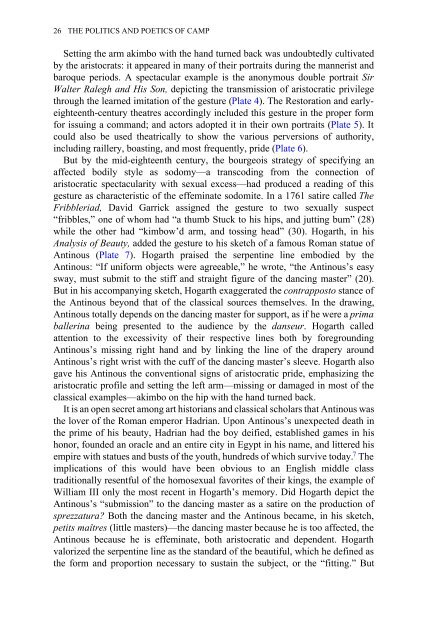Edited by Moe Meyer - Get a Free Blog
Edited by Moe Meyer - Get a Free Blog
Edited by Moe Meyer - Get a Free Blog
Create successful ePaper yourself
Turn your PDF publications into a flip-book with our unique Google optimized e-Paper software.
26 THE POLITICS AND POETICS OF CAMP<br />
Setting the arm akimbo with the hand turned back was undoubtedly cultivated<br />
<strong>by</strong> the aristocrats: it appeared in many of their portraits during the mannerist and<br />
baroque periods. A spectacular example is the anonymous double portrait Sir<br />
Walter Ralegh and His Son, depicting the transmission of aristocratic privilege<br />
through the learned imitation of the gesture (Plate 4). The Restoration and earlyeighteenth-century<br />
theatres accordingly included this gesture in the proper form<br />
for issuing a command; and actors adopted it in their own portraits (Plate 5). It<br />
could also be used theatrically to show the various perversions of authority,<br />
including raillery, boasting, and most frequently, pride (Plate 6).<br />
But <strong>by</strong> the mid-eighteenth century, the bourgeois strategy of specifying an<br />
affected bodily style as sodomy—a transcoding from the connection of<br />
aristocratic spectacularity with sexual excess—had produced a reading of this<br />
gesture as characteristic of the effeminate sodomite. In a 1761 satire called The<br />
Fribbleriad, David Garrick assigned the gesture to two sexually suspect<br />
“fribbles,” one of whom had “a thumb Stuck to his hips, and jutting bum” (28)<br />
while the other had “kimbow’d arm, and tossing head” (30). Hogarth, in his<br />
Analysis of Beauty, added the gesture to his sketch of a famous Roman statue of<br />
Antinous (Plate 7). Hogarth praised the serpentine line embodied <strong>by</strong> the<br />
Antinous: “If uniform objects were agreeable,” he wrote, “the Antinous’s easy<br />
sway, must submit to the stiff and straight figure of the dancing master” (20).<br />
But in his accompanying sketch, Hogarth exaggerated the contrapposto stance of<br />
the Antinous beyond that of the classical sources themselves. In the drawing,<br />
Antinous totally depends on the dancing master for support, as if he were a prima<br />
ballerina being presented to the audience <strong>by</strong> the danseur. Hogarth called<br />
attention to the excessivity of their respective lines both <strong>by</strong> foregrounding<br />
Antinous’s missing right hand and <strong>by</strong> linking the line of the drapery around<br />
Antinous’s right wrist with the cuff of the dancing master’s sleeve. Hogarth also<br />
gave his Antinous the conventional signs of aristocratic pride, emphasizing the<br />
aristocratic profile and setting the left arm—missing or damaged in most of the<br />
classical examples—akimbo on the hip with the hand turned back.<br />
It is an open secret among art historians and classical scholars that Antinous was<br />
the lover of the Roman emperor Hadrian. Upon Antinous’s unexpected death in<br />
the prime of his beauty, Hadrian had the boy deified, established games in his<br />
honor, founded an oracle and an entire city in Egypt in his name, and littered his<br />
empire with statues and busts of the youth, hundreds of which survive today. 7 The<br />
implications of this would have been obvious to an English middle class<br />
traditionally resentful of the homosexual favorites of their kings, the example of<br />
William III only the most recent in Hogarth’s memory. Did Hogarth depict the<br />
Antinous’s “submission” to the dancing master as a satire on the production of<br />
sprezzatura? Both the dancing master and the Antinous became, in his sketch,<br />
petits maîtres (little masters)—the dancing master because he is too affected, the<br />
Antinous because he is effeminate, both aristocratic and dependent. Hogarth<br />
valorized the serpentine line as the standard of the beautiful, which he defined as<br />
the form and proportion necessary to sustain the subject, or the “fitting.” But


